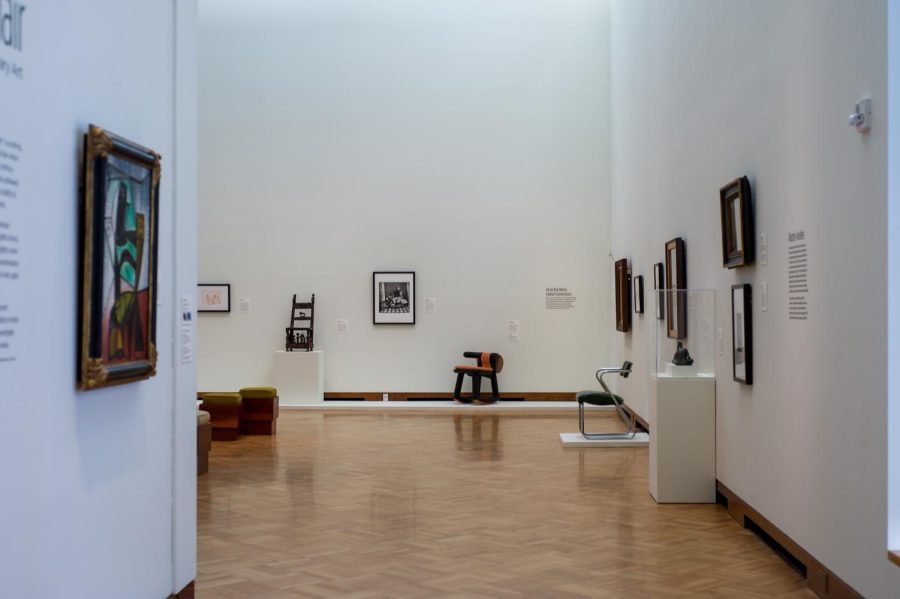Latest AMAM Exhibition Examines Ableist Barriers to Museum Access
To sit or not to sit — or rather, who is allowed to sit and who the chair excludes — is the question extant at the heart of the Allen Memorial Art Museum’s new exhibition, titled Like a Good Armchair: Getting Uncomfortable with Modern and Contemporary Art. This title, though rife with multilayered significance, also refers to the exhibit’s very literal foci: the large, high-ceilinged Ellen Johnson Gallery is populated both by actual chairs and “chair-adjacent” work. Though this may strike you as a fairly specific focal point, chairs and the act of sitting constitute a throughline with ample room to expound a thorough and diverse examination of “the racial, ableist, gendered, and ageist politics of who gets to sit, when, and how.”
The lens of analysis deployed here seems to call into question the falsifiable construction of the Western universal museum itself, which purports a neutral exploration of non-Western visual culture but trends heavily toward the solidification of colonialist agenda through typified modes of representation. In the case of the AMAM’s new exhibition, the concept of the chair seems to likewise refer to a sort of universal chair, a systemically exclusive construction that can be seen effectively disseminated through the exhibition’s rich and diasporic works and narratives.
Organized by Sam Adams, Ellen Johnson ’33 Assistant Curator of Modern and Contemporary Art, and Fudi Fickenscher, OC ’23, the exhibition implements and recontextualizes a formidable array of works from the AMAM’s collection in order to forge an effective echo chamber between older work from prominent names such as Klimt, Segal, and Warhol, as well as newer figures whose work largely probes the economics and highfalutin’ aesthetic standards of the Western museum institution, positioning the history and power of the marginalized body at their forefront. The gallery is organized into a series of sub-sections titled “Wartime Anxieties,” “Ancestral Roots,” “Global Connections,” “Anthropomorphic Materials,” “Design and Identity,” “Postures of Power and Deference,” and “Sitting in One’s Power.” The latter of these categories contains a work that — in my viewing experience — is striking. Toward the center of a free-standing wall lies Titus Kaphar’s offset lithograph poster, “Analogous Colors,” which was on the cover of TIME magazine in 2020. The painting, which depicts a Black mother holding tight to an absent baby, a gaping space subtracted from the work’s center, was created by Kaphar in response to the murder of George Floyd. The piece is accompanied by John Wilson’s 1956 lithograph “Mother and Child,” Burton Silverman’s graphite drawing “Bus Stop Downtown Montgomery” — an image from a series depicting the Montgomery Bus Boycott of 1955–56 — and an image from Civil Rights photographer Ernest C. Withers titled “First Desegregated Bus Ride: Dr. Martin Luther King and Rev. Ralph Abernathy on first desegregated bus, Montgomery, Alabama, December 1956.” These works constitute some of the exhibition’s most powerful explorations of the societal power and historical trauma encapsulated within the act of sitting.
On the opposite wall, “Postures of Power and Deference” presents images of female sitters from aforementioned old and famous names and asks the viewer to examine the psychological complexity ushered by the subjects’ subdued kinesthetic arrangements: “While stylistically progressive, many of these works reflect the misogynistic dynamics of gender and bodily agency of their respective social contexts.” The works are accompanied solely by labels rather than illuminating text, which seems to enact an apt refusal to canonize the famed artists who perpetuated such inanimate representations of the classical female body.
In contrast, a photograph within a separate section titled “Caprice, 55, Chicago, IL, 2015” from Jess T. Dugan’s portfolio To Survive on this Shore: Photographs and Interviews with Transgender and Gender Nonconforming Older Adults is accompanied by one of the longest wall texts I’ve seen. The text contains the transcription of an accompanying interview with the photograph’s sitter, Caprice. The interview’s first lines reads: “I’m a fifty-five year old woman of trans experience and a woman of color. And my life is amazing. I am the eighth child of twenty-three.” The space provided for her words, her insight, is a space that the museum institution should continually hold, but typically pushes to the margin. It was nice to note the curators’ tactics in clumping more antiquated work into breathless quarters while providing room and platform for newer works with more nuanced, potent, and anticolonial messaging.
It should be noted that there are a few actually sittable chairs within the exhibition: cushioned, cube-like stools titled “Frank Lloyd Wright hassocks” and the inscribed “Shannon Finnegan bench.” The former exists in company with Robert Venturi’s 1983 “Queen Anne Side Chair in ‘Grandmother’ Pattern” — a piece of furniture constructed by the Museum’s very own contributing architect. The latter, a large blue bench, proves more subversive. The bench, which sits within the gallery’s second enclave, reads: “This exhibition has asked me to stand for too long. Sit if you agree.” This imperative refers to museums’ classic dependency on compulsory able-bodiedness, a tenet which the field of disability aesthetics — totally and thematically engendered by the exhibition — serves to disassemble. According to many museum and disability studies scholars, the curator should act as an infrastructural activist, outfitting museum spaces with sitting areas so that the space is accessible not only to the classic able body. The bench thus provides literal respite for the museum-goer and suspends a subliminal critique of the museum institution’s ableist composition.
Shannon Finnegan, the bench’s creator and an artist who experiments “with forms of access that intervene in ableist structures with humor, earnestness, and rage,” will host a talk titled “Accessibility Dreams” through the Allen After Hours program April 6 at 5:30 p.m. On February 16 Chicago-based artist and designer Norman Teague, creator of “Africana Rocking Chair,” will also be hosting “A Conversation and Performance with Norman Teague.”






